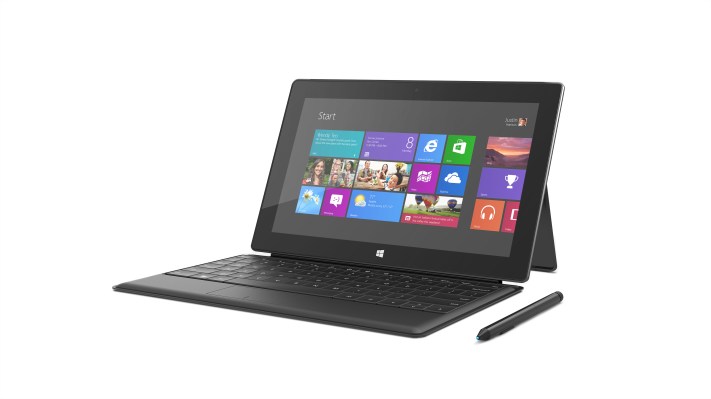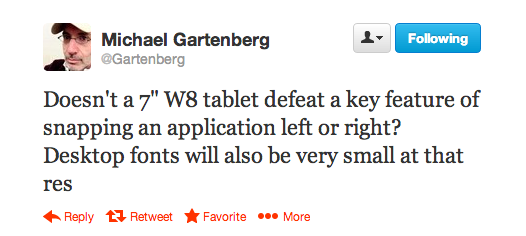According to a report in the WSJ, Microsoft is working on a new line-up of its Windows 8-powered Surface tablets that includes a seven inch version of the slate. This small form factor size would enable Microsoft to compete with the likes of the Android-powered Google Nexus 7, Amazon Kindle Fire and Samsung Galaxy Tab 2, as well as Apple’s iOS-based iPad Mini.
The paper quotes a person familiar with the situation saying that while 7-inch tablets were not part of Microsoft’s product plans last year company executives have realised they need to respond to the growth and popularity of small slates. Which boils down to Redmond is having to play catch up yet again.
Microsoft has previously been tipped to release three new and distinct generations of Surface this year — albeit, none of those prior rumours had pointed to a seven inch device. And perhaps with good reason, as Gartner analyst Michael Gartenberg noted via Twitter today the small tablet form factor poses some usability challenges for Microsoft’s full-fat Windows OS. Rival small slates are powered by lighter weight mobile OSes, and while Microsoft has now unified its smartphone (Windows Phone) and desktop OSes on a shared kernel it’s still using ‘desktop’ Windows for tablets.
But it’s not just that computing devices are getting smaller. Shrinkage appears inextricably linked with the market in another way. Gartner put out its figures for worldwide PC shipments for Q1 late yesterday — which show shipments declining to their lowest level since Q2 2009. The analyst says alternative smart connected devices — aka those small smartphones and tablets running lighter weight smartphone OSes — are eroding the traditional PC market.
Global PC shipments totalled 79.2 million units in Q1 2013, which Gartner said was an 11.2% year-on-year decline. All global regions showed a decrease in shipments, with the EMEA region experiencing the steepest decline.
“Consumers are migrating content consumption from PCs to other connected devices, such as tablets and smartphones. Even emerging markets, where PC penetration is low, are not expected to be a strong growth area for PC vendors,” said Mikako Kitagawa, principal analyst at Gartner in a statement.
Microsoft’s Surface tablet straddles the gap between a tablet and a laptop, having a touchscreen and a keyboard cover add-on. But Gartner said touchscreen-based Windows 8 PCs took only a small percentage share of consumer PC shipments in Q1 — owing to their relatively high price.
“Touchscreen-based Ultramobiles [such as Surface Pro] offer PC manufacturers an opportunity to recover market share from media tablets, but Windows 8 PCs with touchscreens accounted for only a small percentage of consumer PC shipments in the first quarter of 2013,” noted Isabelle Durand, principal research analyst at Gartner in a statement. “The majority of consumers remain unwilling to pay the price premium for touchscreen capabilities on PCs at this stage.”
Android tablet sellers including Google and Amazon have been driving down the cost of seven inch slates — with the Nexus 7 and the Kindle Fire currently costing from as little $199 and $159 respectively — and that price erosion is likely helping to accelerate the consumer migration away from the traditional PC category. Microsoft’s Surface RT tablet was priced from $499 at launch, while Surface Pro was from $899.
How Microsoft chooses to price any ‘Surface Mini’ will be key to driving sales — and with the iPad mini starting at $329, there is not much scope for Redmond to be able to undercut the small slate competition. Yet it can’t afford for Surface to fail.
As Gartner analyst Carolina Milanesi told TechCrunch last week, discussing its smart devices forecast: “You need to own consumers in terms of mobile and tablet in order to remain relevant in this market… Consumers have options and consumers are choosing and Microsoft can not take that for granted that they’ll be the one to be chosen.”

